Your browser does not fully support modern features. Please upgrade for a smoother experience.

Submitted Successfully!
Thank you for your contribution! You can also upload a video entry or images related to this topic.
For video creation, please contact our Academic Video Service.
| Version | Summary | Created by | Modification | Content Size | Created at | Operation |
|---|---|---|---|---|---|---|
| 1 | Niranjan Koirala | -- | 1324 | 2022-09-20 11:39:55 | | | |
| 2 | Jessie Wu | Meta information modification | 1324 | 2022-09-21 07:08:05 | | | | |
| 3 | Jessie Wu | Meta information modification | 1324 | 2022-09-21 07:09:38 | | |
Video Upload Options
We provide professional Academic Video Service to translate complex research into visually appealing presentations. Would you like to try it?
Cite
If you have any further questions, please contact Encyclopedia Editorial Office.
Bhatta, R.D.; Paudel, M.; Ghimire, K.; Dahal, K.R.; Amgain, L.P.; Pokhrel, S.; Acharya, S.; Kandel, B.P.; Aryal, K.; C., B.K.; et al. Production of Hybrid Rice. Encyclopedia. Available online: https://encyclopedia.pub/entry/27368 (accessed on 07 January 2026).
Bhatta RD, Paudel M, Ghimire K, Dahal KR, Amgain LP, Pokhrel S, et al. Production of Hybrid Rice. Encyclopedia. Available at: https://encyclopedia.pub/entry/27368. Accessed January 07, 2026.
Bhatta, Ram Datta, Mahendra Paudel, Kishor Ghimire, Khem Raj Dahal, Lal Prasad Amgain, Samiksha Pokhrel, Samikshya Acharya, Bishnu Prasad Kandel, Krishna Aryal, Bishwas K. C., et al. "Production of Hybrid Rice" Encyclopedia, https://encyclopedia.pub/entry/27368 (accessed January 07, 2026).
Bhatta, R.D., Paudel, M., Ghimire, K., Dahal, K.R., Amgain, L.P., Pokhrel, S., Acharya, S., Kandel, B.P., Aryal, K., C., B.K., Pandey, M., Kc, Y., Paudel, S., Subedi, M., Pant, B.R., Bajgai, T.R., Koirala, N., Aboelenin, S.M., Soliman, M.M., ... Upadhyaya, J. (2022, September 20). Production of Hybrid Rice. In Encyclopedia. https://encyclopedia.pub/entry/27368
Bhatta, Ram Datta, et al. "Production of Hybrid Rice." Encyclopedia. Web. 20 September, 2022.
Copy Citation
Rice, being an important cereal, fills the food needs of more than half of the world's population, despite its production and profitability nutrient management techniques. The government of Nepal has recommended blanket fertilizer application, which results in lower nutrient use efficiency (NUE) particularly under rainfed conditions. With the aim of finding most appropriate nutrient management practices concerning rice production and profitability, A field experiment was conducted during the rainy season of 2017 and 2018 at Kavre and Dang district of Nepal.
hybrid rice
nutrient management practices
production and profitability
fertilizer
1. Background
Globally, rice is cultivated over 162.06 million hectares, producing 504.17 million metric tons of milled rice in 2019 [1]. Rice is mainly grown and consumed in Asian countries (China, India, Indonesia, Bangladesh, Vietnam) with 80% of global production [2]. In Nepal, rice is cultivated in 1,458,915-hectare, producing 5,550,878 metric tons of rice, with an average productivity of 3.8 tons/ha during fiscal year 2019–2020 [3]. Nepal’s Gross Domestic Product (GDP) is largely sustained by agriculture, of which rice alone represents 20.75 percent [4]. Nepal’s current rice demand (2512 tons currently) is predicted to double by 2030 (4518 tons) due to population pressure. Further, the study of [5] forecasted that household demand and production would fluctuate from 19% to 80% by 2030. It is necessary to increase rice production and productivity to close the gap in supply and demand with the limited resource available, owing to the unstable rice yield due to insect, pest, nematodes, declination of soil fertility, imbalanced fertilizer use and poor nutrient management practices [6][7].
In Nepal, rice is grown with urea as the primary nitrogen source, but plants utilize only 30% of the applied urea, whereas the rest 70% is lost due to NH3 volatilization, surface runoff and leaching in lowland rice therefore, rice farmers need to maximize nitrogen use efficiency (NUE) while maintaining low nitrogen inputs [8][9]. Concept of Site-Specific Nutrient Management (SSNM) was developed to apply nutrients at the optimal rates with maximum nutrient use efficiency [10]. SSNM is a component of precision agriculture as it combines the nutrient requirements of plants at various growth stages with the soil’s ability to supplying them. Further, SSNM integrates with Nutrient Expert; computer-based tool to estimate fertilizer requirement considering nutrient use efficiency, estimated yield, along with nutrient balance and added nutrients effect on yield [11]. SSNM principles recommend fertilizer based on the 4’R’-right dose, right method, right source, and right timing [12].
2. Result of Mean Performance of Rice Traits
2.1. Plant Height (PH)
An analysis of variance revealed a highly significant difference (p < 0.01) between the treatments for plants in Dang, but while in Kavre difference was not significant statistically (Figure 1). The overall mean of the plant height was 91.63 cm. The mean plant height was 87.47 cm and 95.78 cm in Kavre and Dang, respectively. Plant height was maximum in FYM (91.58 cm) and minimum in NE (83.76 cm) at Kavre while at Dang maximum plant height was observed in NE (99.89 cm), followed by GON (98.41 cm) and minimum plant height was observed in FFP (88.39), respectively). These findings are supported by report of [13].
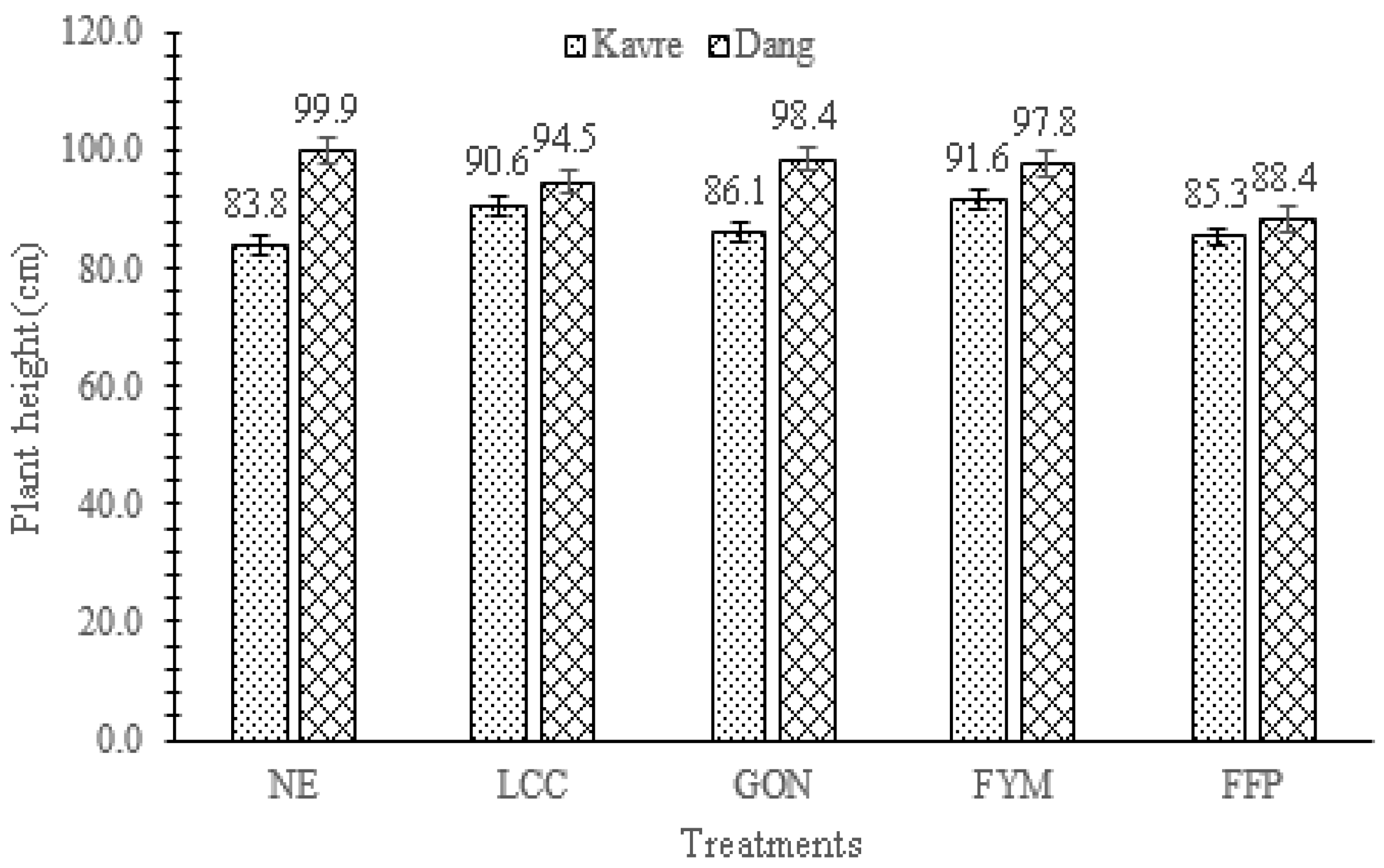
Figure 1. Effect of nutrient management practices on Plant Height of Rice at Kavrepalanchowk and Dang.
2.2. Number of Effective Tiller (NOET)
A significant difference (p < 0.05) was found for the number of effective tillers per m2 at Kavre, while it was not significant at Dang (Figure 2). The mean number of tillers per m2 was 258, 363, and 315.50 in Kavre, Dang and the overall field, respectively. The number of effective tillers per m2 was highest in GON plots (278.40) followed by LCC (273.00) and minimum in FFP plots (224.80) in Kavre while LCC had the maximum number of effective tillers per m2 (387.65) and NE had the lowest number of effective tillers per m2 (355.20) at harvest in Dang.
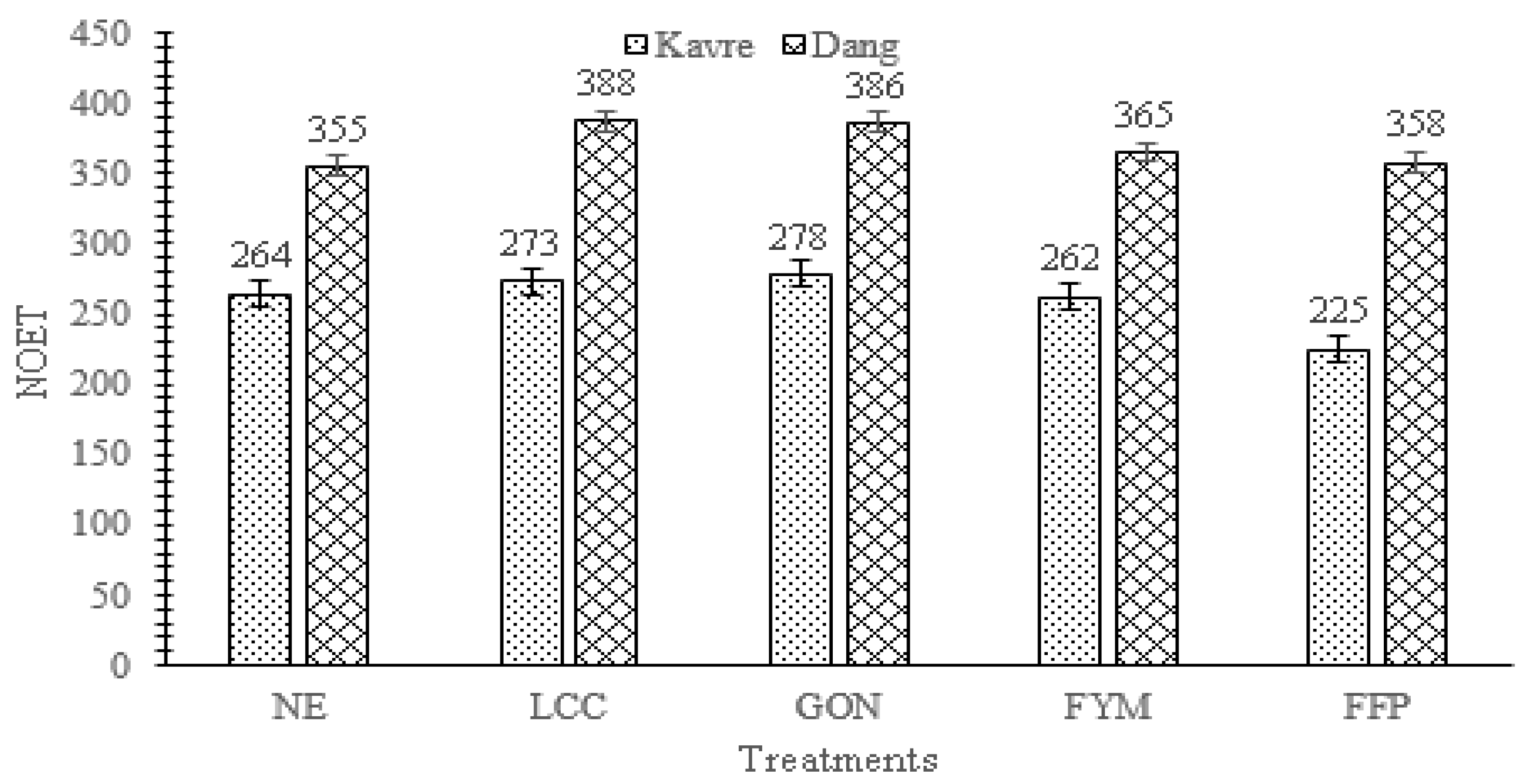
Figure 2. Effect of nutrient management practices on Number of Effective Tillers per Square Meter of Rice at Kavrepalanchowk and Dang.
2.3. Panicle Length (PL)
Panicle length was statistically significant (p < 0.01) in Dang while non-significant in Kavre (Figure 3). The overall mean of the panicle length was 24.76 cm. Kavre and Dang had mean panicle lengths of 26.92 cm and 22.59 cm, respectively.
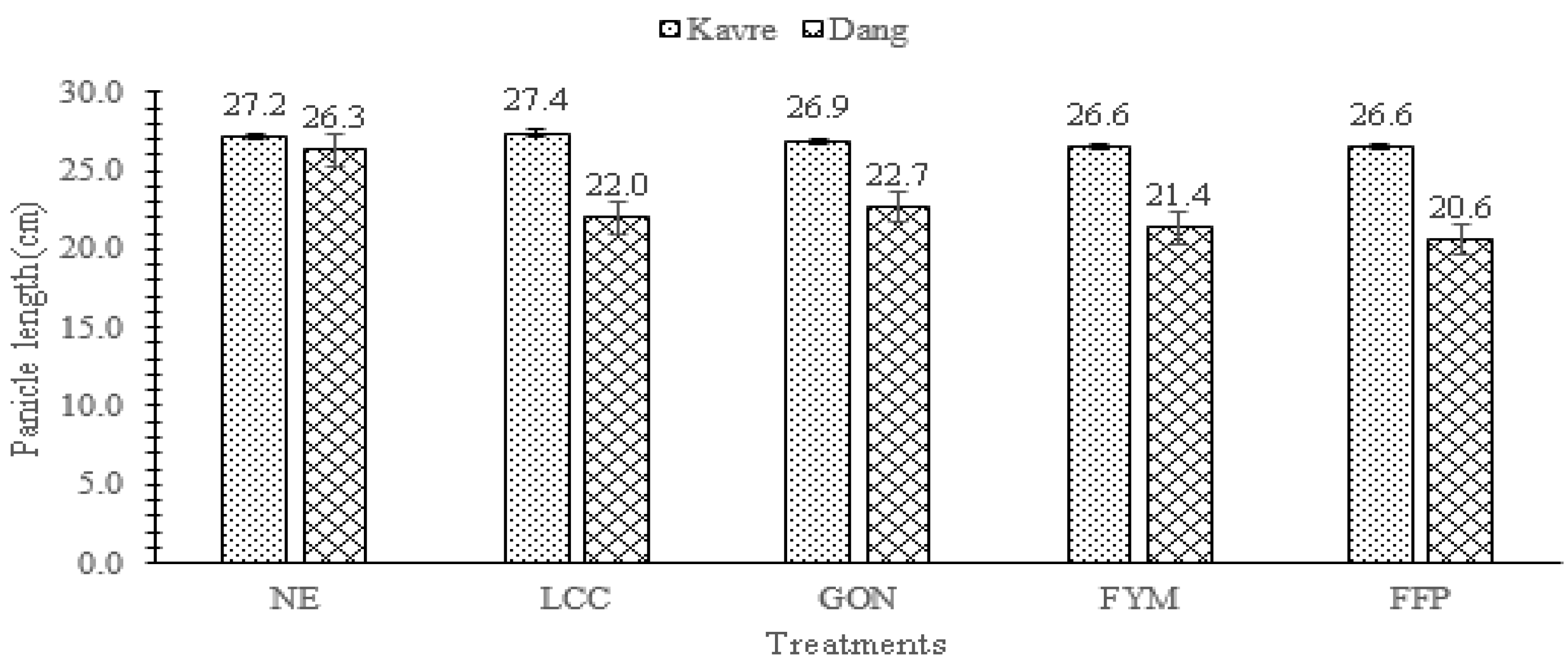
Figure 3. Effect of nutrient management practices on Panicle Length of rice at Kavrepalanchowk and Dang.
2.4. Kavre
LCC had the longest panicle length (27.41 cm), followed by NE (27.18 cm), and FYM and FPP both had the shortest panicles (26.56 cm). These result are in line with result obtained by [14].
2.5. Dang
The longest panicle length was found in NE (26.31 cm) which was statically superior to all other treatments. The shortest panicle was found in FPP (20.61 cm) which was statistically at par with LCC, GON, and FYM. Similar result was obtained by [15].
2.6. Fertility (FT)
In Kavre, there was no significant difference between treatments in regards to percentage fertility, while in Dang, there was significant difference (Figure 4). The overall mean of the fertility was 77.40%. The mean percentage of fertility in Kavre and Dang were 72.6% and 82.2%, respectively. The percentage of fertility ranged from 68.5% to 80.25% with highest fertility recorded in LCC and lowest fertility recorded in FYM in Kavre. In dang, the percentage of fertility ranged from 67.24% to 90.52%. The highest fertility recorded in FYM was statistically superior to other treatments. It was followed by LCC (88.12%) and NE (87.56%). The lowest fertility recorded in FPP.
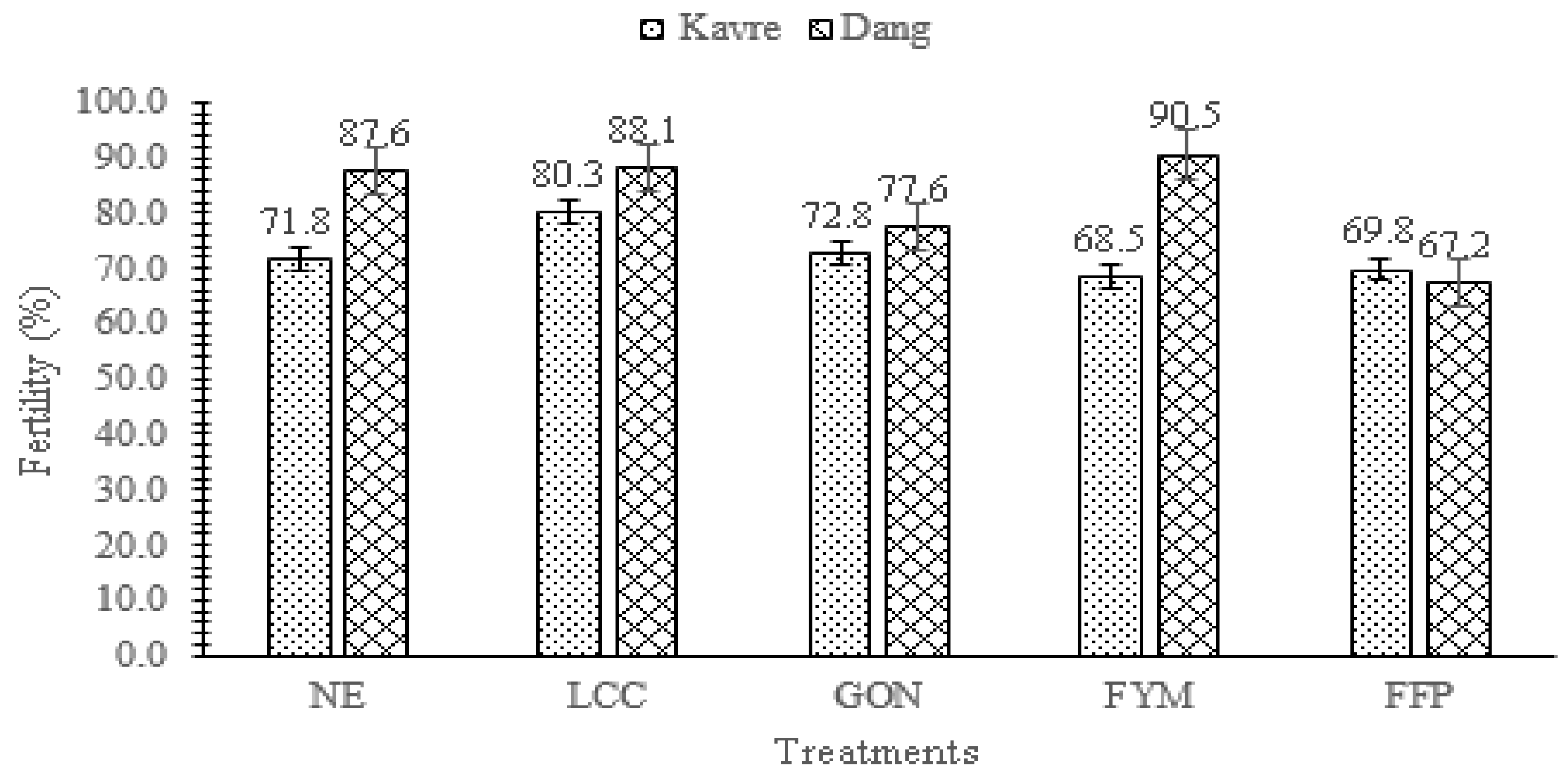
Figure 4. Effect of nutrient management practices on Fertility of rice at Kavrepalanchowk and Dang.
2.7. Test Weight
The ANOVA showed significant effects (p < 0.01) of treatments on test weight of rice in both Kavre and Dang (Figure 5). The mean thousand grain weight was 15.7 g in Kavre and was 15.75 g in Dang. The overall mean was 15.73 g.
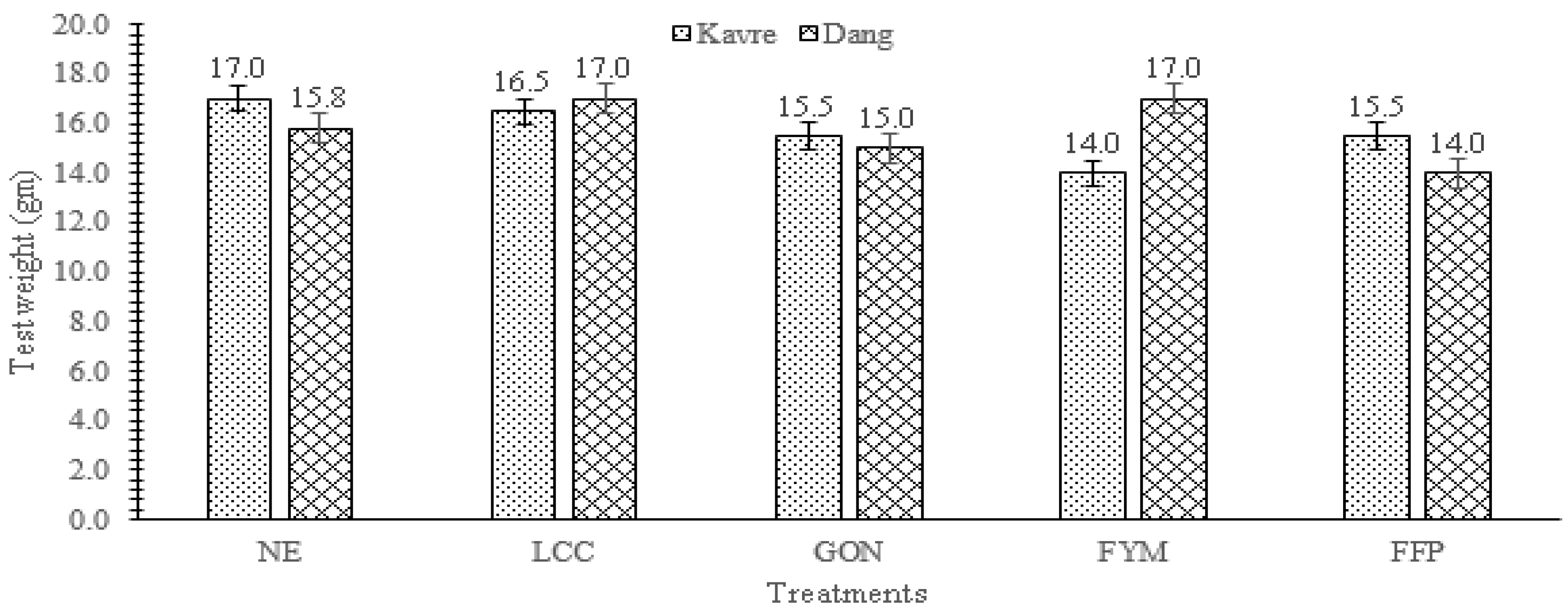
Figure 5. Effect of nutrient management practices on test weight of rice at Kavrepalanchowk and Dang.
In Kavre, the maximum test weight recorded was 17.0 g in NE which was followed by LCC (16.5 g). While, the minimum test weight recorded was 14.0 g in FYM. Similarly, in Dang, the maximum test weight recorded was 17.00 g in FYM and LCC. While, the minimum test weight recorded was 14.0 g in FPP.
2.8. Grain Yield
2.8.1. Kavrepalanchowk
The ANOVA elucidated significant effects of treatments on grain yield of rice at 0.05 level of significance (Figure 6). The highest grain yield (5.84 t/ha) was recorded in NE management followed by LCC (5.61 t/ha), GON (5.34 t/ha) and FYM (5.14 t/ha). The lowest yield (4.10 t/ha) was obtained in FYM.
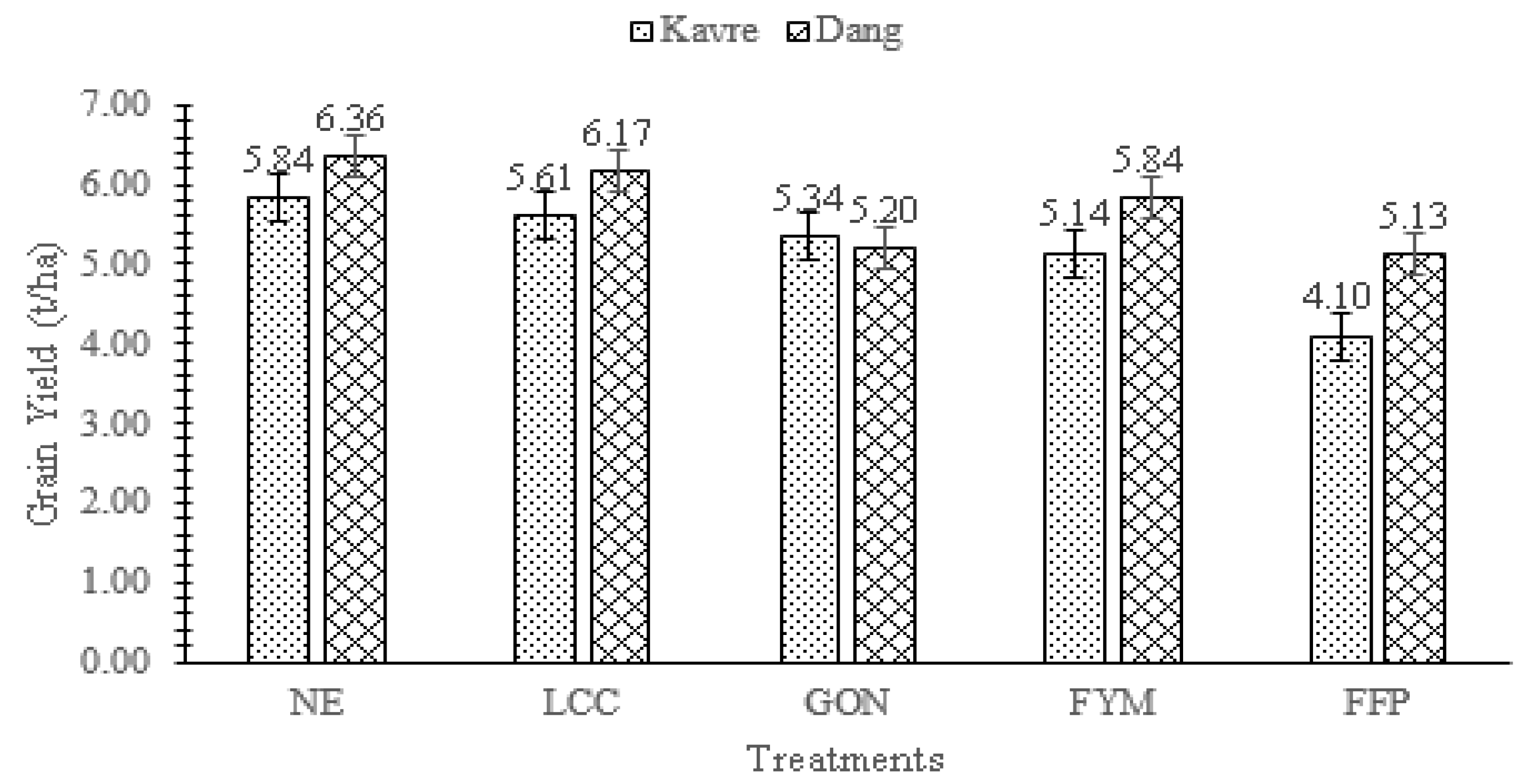
Figure 6. Effect of nutrient management practices on grain yield of rice at Kavrepalanchowk and Dang.
2.8.2. Dang
The ANOVA elucidated treatments caused significant variation on the grain yield of rice at 0.01 level of significance. The highest grain yield of rice (6.36 t/ha) was recorded in NE in NE management followed by LCC (6.17 t/ha), and FYM (5.8004 t/ha). The lowest yield (5.13 t/ha and 5.20 t/ha) was obtained in FPP and GON, statically at par with FYM.
2.9. Straw Yield
There was significant difference between nutrient management treatments for straw yield in Kavre and Dang (Figure 7). The mean straw yield in Kavre was 10.9 t/ha and in Dang was 10.97 t/ha. The overall mean was found to be 10.93 t/ha. The highest straw yield was 12.04 t/ha in FFP, followed by 11.50 t/ha in GON statistically at par with FFP while the lowest yield was found in LCC (9.50 t/ha) in Kavre. In Dang, the highest straw yield was found in LCC (12.87 t/ha) statistically at par with NE (12.62 t/ha). The lowest straw yield was found in FFP (12.04 t/ha).
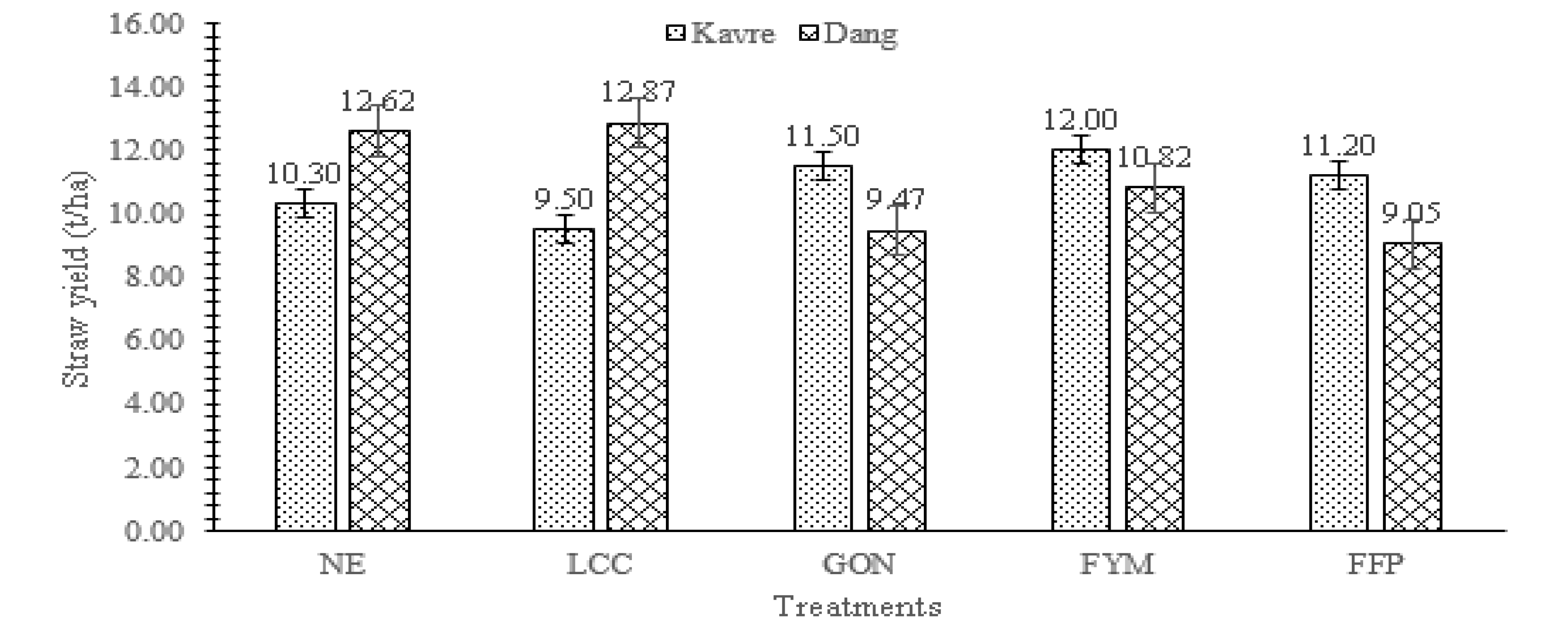
Figure 7. Effect of nutrient management practices on straw yield of rice at Kavrepalanchowk and Dang.
3. Harvest Index
The harvest index between treatments differed significantly in Dang while it did not differ significantly in Kavre (Figure 8). The mean harvest index was 33.92% and 35.76% in Kavre and Dang, respectively.

Figure 8. Effect of nutrient management practices on harvest index of rice at Kavrepalanchowk and Dang.
3.1. Kavrepalanchowk
In terms of harvest index, NE had the highest harvest index with 38.52%, followed by LCC with 38.47%. The lowest harvest index was found in FYM (29.20%). Ref. [16] reported NE in wheat produces 38% higher harvest index than FFP, which is consistent with researcher's findings.
3.2. Dang
Significantly higher harvest index was obtained from NE fertilizer recommendation (41.38%) than other treatments, followed by LCC (39.57%) which are statistically at par. The lowest harvest index found was 28.73% in FYM.
References
- Shahbandeh, M. World Production Volume of Milled Rice from 2008/2009 to 2020/2021. 2021. Available online: https://www.statista.com/statistics/271972/world-husked-rice-production-volume-since-2008/ (accessed on 9 June 2021).
- Abdullah, A.; Kobayashi, H.; Matsumura, I.; Ito, S. World Rice Demand towards 2050: Impact of Decreasing Demand of Per Capita Rice Consumption for China and India. 2008. Available online: https://www.semanticscholar.org/paper/World-Rice-Demand-Towards-2050%3A-Impact-of-Demand-of-Ito/260f4d3b195718591a8143982ec4cffa66f8f338 (accessed on 9 June 2021).
- MoALD. Selected Indicators of Nepalese Agriculture. Available online: https://nepalindata.com/ (accessed on 9 June 2021).
- ABPSD. Statistical Information on Nepalese Agriculture 2013/14 (2070/071), Agri Statistics Section, Agri Business Promotion and Statistics Division; Government of Nepal; Ministry of Agriculture and Co-Operatives; ABPSD: Kathmandu, Nepal, 2014.
- Prasad, K.; Singh, R.; Singh, S. Effect of seedlings age and number of seedlings per hill on the yield of rice in a sodic soil. Curr. Agric. 2011, 16, 67–70.
- Katoch, P.; Katoch, A.; Podel, M.; Uperti, S. Bakanae of Rice: A serious disease in Punjab. Int. J. Curr. Microbiol. Appl. Sci. 2019, 8, 129–136.
- Baral, B.R.; Pande, K.R.; Gaihre, Y.K.; Baral, K.R.; Sah, S.K.; Thapa, Y.B. Farmers’ fertilizer application gap in rice-based cropping system: A case study of Nepal. SAARC J. Agric. 2019, 17, 267–277.
- Matsushima, S. High Yielding Rice Cultivation; University of Tokyo Press: Tokyo, Japan, 1976.
- Ladha, J.K.; Pathak, H.; Krupnik, T.J.J.; Six, J.; Van Kessel, C. Efficiency of fertilizer nitrogen in cereal production: Retrospects and prospects. Adv. Agron. 2005, 87, 85–156.
- Joshy, D. Soil Fertility and Fertilizer Use in Nepal. 1997. Available online: https://agris.fao.org/agris-search/search.do?recordID=NP9700156 (accessed on 9 June 2021).
- Witt, C.; Buresh, R.J.; Peng, S.; Balasubramanian, V.; Dobermann, A. Nutrient management. In Rice A Practical Guide to Nutrient Management; Fairhurst, T.H., Witt, C., Buresh, R., Dobermann, A., Eds.; International Rice Research Institute: Los Baños, Philippines, 2007.
- Satyanarayana, T.; Majumdar, K.; Pampolino, M.; Johnston, A.M.; Jat, M.L.; Kuchanur, P.; Sreelatha, D.; Sekhar, J.C.; Kumar, Y.; Maheswaran, R.; et al. Nutrient Expert TM: A Tool to Optimize Nutrient Use and Improve Productivity of Maize. Better Crop. 2013, 97, 21–24.
- Meena, S.L.; Singh, S.; Shivay, Y.S. Response of hybrid rice (Oryza sativa) to nitrogen and potassium application in sandy clay-loam soils. Indian J. Agric. Sci. 2003, 73, 8–11.
- Aslam, M.M.; Zeeshan, M.; Irum, A.; Hassan, M.U.; Ali, S.; Hussain, R.; Ramzani, P.M.A.; Rashid, M.F. Influence of Seedling Age and Nitrogen Rates on Productivity of Rice (Oryza sativa L.): A Review. Am. J. Plant Sci. 2015, 6, 1361–1369.
- Subedi, R. Nursery Management Influences Yield and Yield Attributes of Rainfed Lowland Rice. J. Sustain. Soc. 2013, 2, 86–91.
- Dutta, S.K.; Majumdar, K.; Satyanarayana, T. India, Nutrient Expert: A precisionnutrient management tool for smallholder production systems of India. Crop Soils Mag. 2014, 47, 23–25.
More
Information
Subjects:
Agronomy
Contributors
MDPI registered users' name will be linked to their SciProfiles pages. To register with us, please refer to https://encyclopedia.pub/register
:
View Times:
806
Revisions:
3 times
(View History)
Update Date:
27 Sep 2022
Notice
You are not a member of the advisory board for this topic. If you want to update advisory board member profile, please contact office@encyclopedia.pub.
OK
Confirm
Only members of the Encyclopedia advisory board for this topic are allowed to note entries. Would you like to become an advisory board member of the Encyclopedia?
Yes
No
${ textCharacter }/${ maxCharacter }
Submit
Cancel
Back
Comments
${ item }
|
More
No more~
There is no comment~
${ textCharacter }/${ maxCharacter }
Submit
Cancel
${ selectedItem.replyTextCharacter }/${ selectedItem.replyMaxCharacter }
Submit
Cancel
Confirm
Are you sure to Delete?
Yes
No




